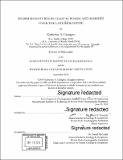Storm signatures in coastal ponds and marshes over the late Holocene
Author(s)
Castagno, Katherine Amelia.
Download1138876616-MIT.pdf (22.06Mb)
Other Contributors
Joint Program in Oceanography/Applied Ocean Science and Engineering.
Massachusetts Institute of Technology. Department of Earth, Atmospheric, and Planetary Sciences.
Woods Hole Oceanographic Institution.
Advisor
Jeffrey P. Donnelly.
Terms of use
Metadata
Show full item recordAbstract
Tropical cyclones pose a growing threat to coastal populations, especially as both populations and infrastructure are increasingly concentrated along the eastern coast of the United States. This thesis seeks to characterize the impacts of storms on coastal ponds and marshes along the eastern coast of the United States. Tropical cyclones and other storms have been shown to cause a spectrum of effects on these coastal systems, ranging from widespread erosion to deposition of thick sediment deposits. Sediments deposited and preserved in coastal ponds and marshes can provide a proxy for tropical cyclone landfall, the development and interpretation of which is imperative to understanding past climate trends and informing decisions for the future. This thesis uses a variety of methods to quantify the spatiotemporal signatures of tropical cyclone events in coastal, marsh, bay, and pond systems in Massachusetts, Connecticut, and Virginia. Trends in grain-size distribution and sediment coarse fraction are used to broaden our understanding of deposition and sediment sources during tropical cyclone events. The complexity of how storms interact with these systems requires a process-based, whole-site analysis to adequately develop a storm record. Given the many nuances to storm deposition in these systems (including reverse grading trends and apparent spatiotemporal variation in sediment source), the potential utility and caveats to inversely modeling storm intensity from deposit grain-size characteristics is discussed. Finally, the question of whether hurricanes can produce widespread erosion of marsh platforms is addressed through both field and modeling techniques. While storms typically deposit sediment, field evidence suggests that marshes have the potential to be eroded by a series of storms over time-a deviation from our traditional understanding of marsh evolution. Deposition and erosion of sediment during major storms remain complex, emphasizing the importance of contextualizing storm signatures within a broader view of the study area. This provides an opportunity to strengthen both paleo-reconstructions of storm activity and our ability to make informed decisions for coastal management in response to potential future changes in storminess.
Description
Thesis: Ph. D., Joint Program in Oceanography/Applied Ocean Science and Engineering (Massachusetts Institute of Technology, Department of Earth, Atmospheric, and Planetary Sciences; and the Woods Hole Oceanographic Institution), 2019 Cataloged from PDF version of thesis. Includes bibliographical references (pages 159-171).
Date issued
2019Department
Joint Program in Oceanography/Applied Ocean Science and Engineering; Massachusetts Institute of Technology. Department of Earth, Atmospheric, and Planetary Sciences; Woods Hole Oceanographic InstitutionPublisher
Massachusetts Institute of Technology
Keywords
Joint Program in Oceanography/Applied Ocean Science and Engineering., Earth, Atmospheric, and Planetary Sciences., Woods Hole Oceanographic Institution.